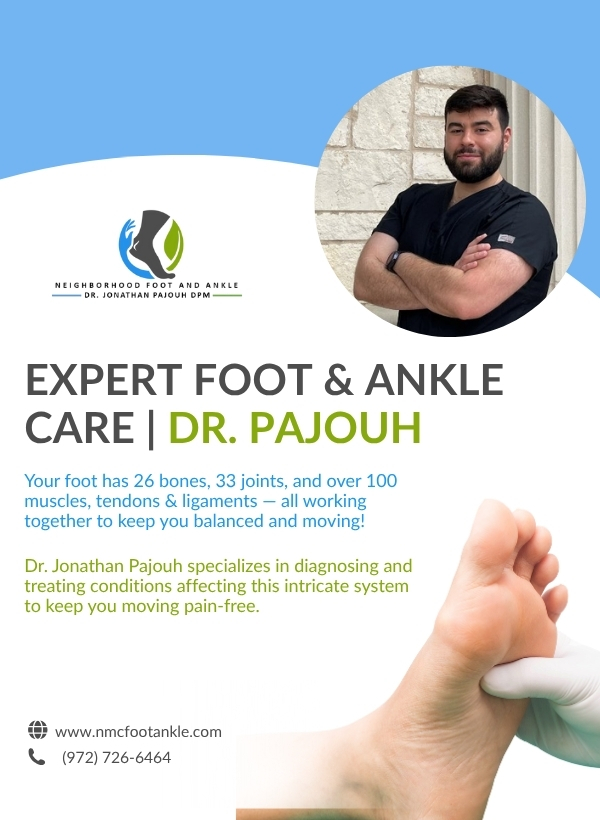Did you know that each foot contains 26 bones, 33 joints, and more than 100 muscles, tendons, and ligaments? This intricate system works in perfect harmony, supporting our every move and maintaining balance. Understanding foot and ankle anatomy is essential, not only to appreciate the mechanics of movement but also to recognize the importance of proper care and treatment for common and complex conditions. In this comprehensive guide, we will dive deeper into the essential components of foot and ankle anatomy, how they interact during daily activities, and why consulting a specialist like Dr. Jonathon Pajouh is crucial for maintaining your mobility and comfort.
The Structure of the Foot
The human foot is a complex structure consisting of 26 bones that are divided into three main sections: the forefoot, midfoot, and hindfoot. Each area has specific roles:
1. Forefoot: This includes the five toes (phalanges) and five long bones (metatarsals) that support our weight and help with balance. The phalanges allow for gripping and pushing off the ground when walking.
2. Midfoot: This section contains five tarsal bones. It acts as a supportive bridge between the forefoot and hindfoot, absorbing shock and allowing flexibility during movement. The midfoot's arch is especially crucial in balancing the weight of the body.
3. Hindfoot: Comprising the heel bone (calcaneus) and the ankle bone (talus), this area connects the foot to the leg. The heel bone bears most of our body weight when standing.
Important Joints and Connective Tissues
The interactions between the bones form the intricate joint system that grants the foot its range of motion. Key joints include:
- Metatarsophalangeal joints: These joints connect the metatarsals to the phalanges, allowing the toes to flex and extend.
- Interphalangeal joints: Allow for movement between the phalanges themselves.
- Subtalar joint: This joint permits side-to-side movement and is essential for walking on uneven surfaces.
- Ankle joint (talocrural joint): Connecting the foot with the leg, this joint facilitates up-and-down foot movements.
Muscles, Tendons, and Ligaments
Beyond bones and joints, over 100 muscles, tendons, and ligaments play critical roles in foot and ankle functionality:
- Muscles: The muscles come in two categories: extrinsic (located in the leg) and intrinsic (located within the foot itself). Extrinsic muscles perform major functions while intrinsic muscles help to stabilize the foot during movement.
- Tendons: Tendons connect muscles to bones and play a significant role in mobility. For example, the Achilles tendon, attaching the calf muscle to the heel, is essential for walking, running, and jumping.
- Ligaments: These connective tissues connect bones to other bones, helping to form and stabilize the joint structures. Ligaments provide the foot and ankle with stability, ensuring proper alignment and movement.
The Ankle: A Key Player in Mobility
The ankle joint is a vital connection between the foot and the leg. It allows for a significant range of motion, supporting various activities, from walking to vigorous sports. The ankle's specific roles include:
- Shock absorption: It absorbs the forces that our bodies exert while walking or running.
- Load distribution: The ankle joint helps transfer body weight evenly through the foot, thereby preventing injuries.
- Interfacing with other regions: The ankle does not work in isolation. It collaborates with the hip, knee, and multitude of surrounding muscle groups to facilitate movement.
Importance of Understanding Foot & Ankle Conditions
Many people underestimate the health of their feet and ankles until they experience pain or discomfort. An understanding of foot and ankle anatomy can empower individuals to recognize common issues such as:
- Plantar Fasciitis: Overuse or structural issues can lead to inflammation of the plantar fascia, causing heel pain.
- Flat Feet: Resulting from structural abnormalities, flat feet can affect overall posture and lead to discomfort.
- Ankle Sprains: Often occurring from improper footing or over-extending the ankle ligaments, sprains can range from mild to severe.
- Bunions: A structural deformity causing the big toe to deviate, often requires intervention if left untreated.
How a Specialist Can Help
If you’re experiencing ongoing foot or ankle issues, consult Dr. Jonathon Pajouh at NMC Foot & Ankle Centers for expert diagnosis and personalized treatment. With expertise in a range of both conservative and advanced treatments, such as orthotics, injections, and surgical solutions like flatfoot reconstruction, total ankle replacement, and minimally invasive corrections, Dr. Pajouh aims to treat the underlying issues rather than just the symptoms.
Preventative Care Techniques for Healthy Feet and Ankles
Incorporating preventative measures into your lifestyle can significantly enhance foot and ankle health:
- Proper footwear: Invest in well-fitting shoes that provide support for your specific type of foot arch.
- Strengthening exercises: Engage in activities that strengthen your foot muscles, such as toe lifts or calf raises.
- Stretching routines: Regular stretching can enhance flexibility and prevent injuries, especially for high-risk groups like athletes.
- Foot hygiene: Maintain foot cleanliness through regular washing and moisturizing to ensure that skin remains elastic and resilient.
Conclusion: The Way Forward
Understanding foot and ankle anatomy is foundational to appreciating how each part plays a role in your mobility. By being aware of health concerns and implementing preventative measures, you can maintain optimal foot health. Regular check-ups with a podiatrist can ensure you remain pain-free and active.
Have foot or ankle pain? Schedule your appointment today!
Contact Us – Reconstructive Podiatric Foot & Ankle Surgeon, Dallas TX

